Following the summer’s trip to the White Mountains on the motorcycle, I decided I wanted go back up for the fall foliage. I’ve done this a couple of times; last time I did this, in 2017, I did it over a weekend. I’ve also done it over the Columbus Day weekend. The trouble with doing it on the weekend, of course, is that when everyone else does it, so this year, I decided to take the first three days of October — Wednesday, Thursday, Friday off from work, and head up. It turned out to be a good move. There were a lot of other people around up there, but it wasn’t overwhelming.
Continue readingCategory Archives: Motorcycling
Motorcycle Trip to the White Mountains
I’ve been feeling that I’ve kind of let the summer slip away, so before it was completely over, I decided to take a couple of days off and take a trip on the motorcycle up to the White Mountains.
Continue readingDamned Mice
I got a custom Corbin saddle for the FJR in August. Overall, it’s been comfortable, and lowers the riding position so that I feel safer with it, but I’ve also noticed my back hurts. This is not necessarily new, but I decided to put the stock seat back on, and check it out.
When I did, I found the under-seat area was filled with pink fiberglass insulation taken from an old roll that’s been in the garage for decades. Clearly, mice have found the bike.

Worse, they’d found the insulation on the wiring harnesses tasty, and had stripped the insulation off.

So now, I have some free time, and the peak foliage season, and I don’t dare use the bike because the electrical system is likely to short out if the wires happen to touch.
About the only good thing about the situation is that I discovered it in the driveway instead of being stranded someplace. I’m enough of a believer in Murphy’s Law to know I’ve dodged a bullet, but the shop can’t even look at it for a couple of weeks, and who knows what they’ll find then. I’m hoping the wiring harness is orderable as a unit, and can simply be replaced completely.
2018 Quechee Balloon Festival, Vermont
I first went to the Quechee Balloon Festival in 2012, with my brother and nephew Matt, who were accompanying one Matt’s friends and father to the festival. I managed to get a balloon ride, and liked it enough to do it again with them the following year.
Since then, they haven’t gone again, and I’ve wanted to go back. I figured this year would be a good year to combine a balloon flight with a short motorcycle tour. So I booked a flight for Friday night, and made motel reservations for Friday and Saturday, in case of weather trouble that would require re-booking the flight.
Friday
I left home around noon on Friday, and ran into heavy traffic in Boston and on Interstate 93 up through New Hampshire. By the time I was on I-89, I’d lost over an hour, and didn’t dare switch over to the side roads.
I did eventually get to the motel barely in time to check in, bring the bags up to the room and switch my boots for sneakers, before heading off in search of the festival grounds.
The Flight
Despite being told to be there by 5 (which is why I was hurrying), they didn’t start processing reservations until 5:30. Finally, after signing off on a lot of paperwork, I got my boarding pass, and met Katherine, from the crew, who took me down to the balloon.
My pilot was Walt Rudy, of Aloft Horizons based in Ohio, and his crew chief was his wife Deb. I met my fellow passengers, and together, we helped get the balloon set up.
The balloon envelope is stored tightly packed inside a big canvas bag. It has to be pulled out to its full height on the ground, unbound, and then spread out flat on the ground.
In the meantime, the basket is laid sideways on the ground, and the envelope fastened to it. Then it was time to wait for the wind to drop, and the festival’s “balloonmeister” to give the ok to launch. It took a while for the winds to abate, but finally we got the go ahead.
The first step in getting a balloon aloft is to “cold inflate” it. The mouth of the balloon is held open by a pair of people — I was one — while fans blow air into the balloon. First there is a ripple of a bubble, and soon enough, while still lying on the ground, it’s nearly its full round shape.
Next, the pilot starts to heat the air, first with a couple of short bursts from the burner, then with longer ones. The envelope develops lift pretty quickly, and starts to pull the basket to a standing position. At that point, the three of us piled in — there is no graceful way to do it–and we sort of “idled” for a moment while Walt got the lay of the land. He added just enough heat to get us just off the ground, and his ground assistants walked the basket a few steps to get clear of our neighbors, and then he blasted the burners again and we were off.




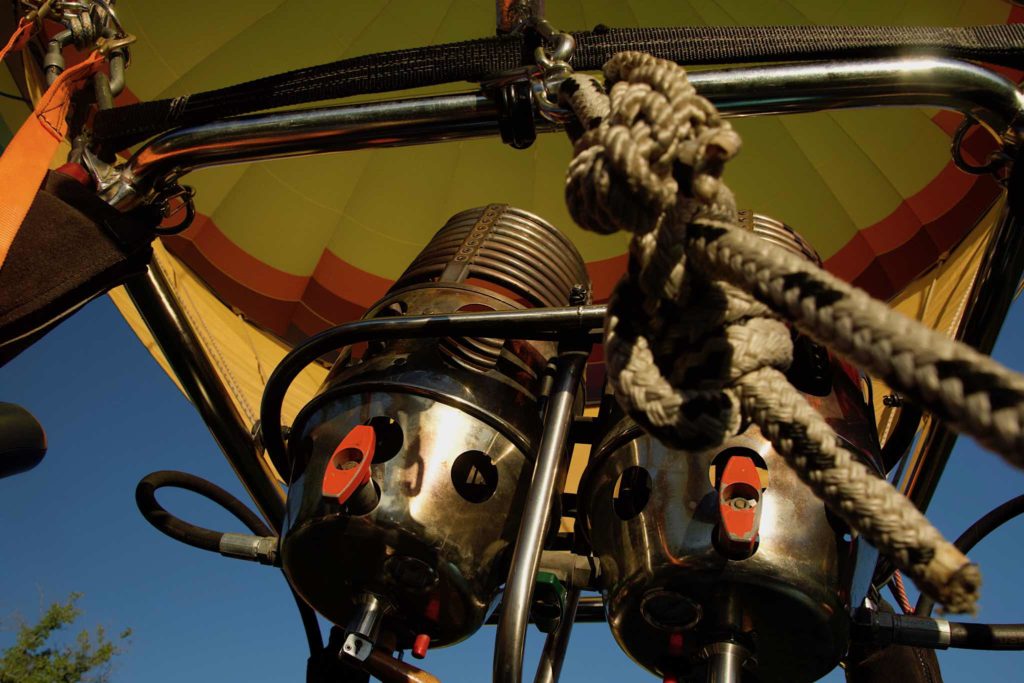
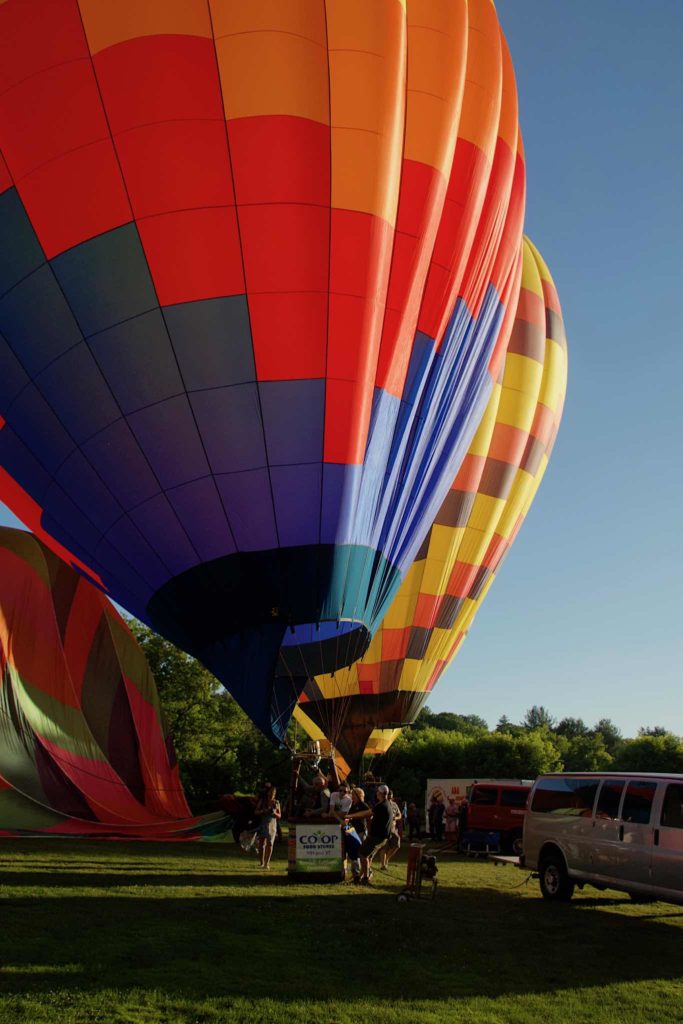






















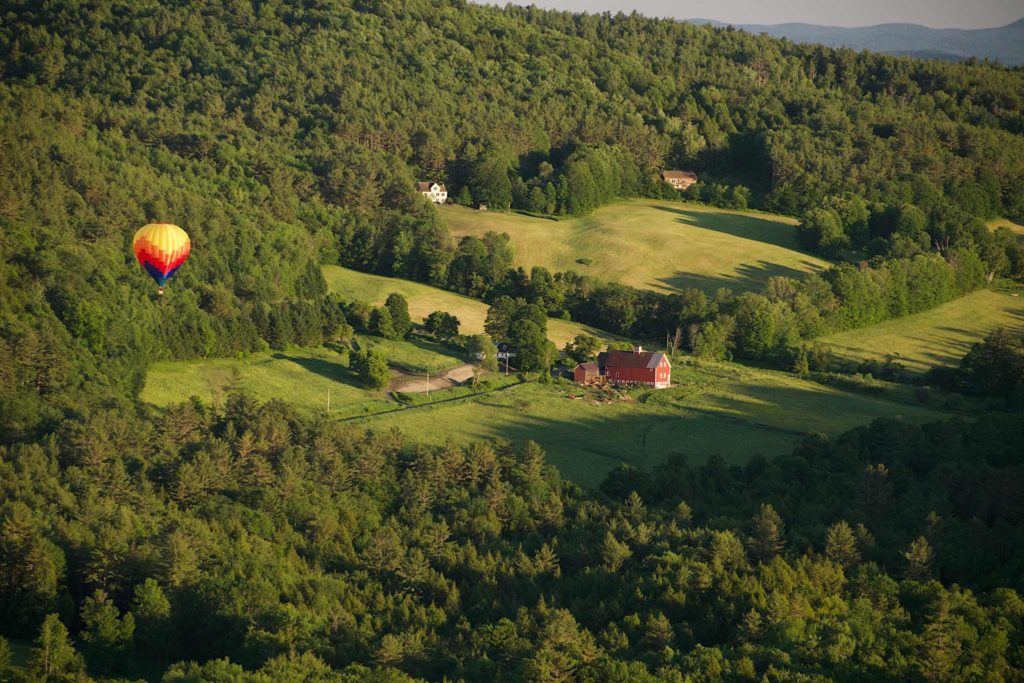
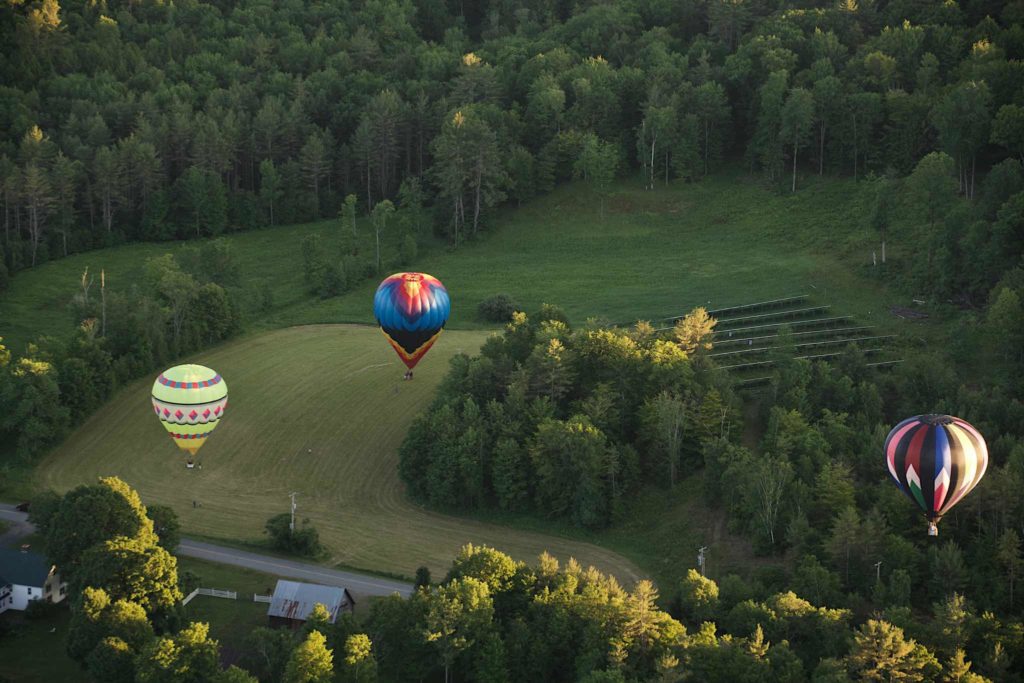


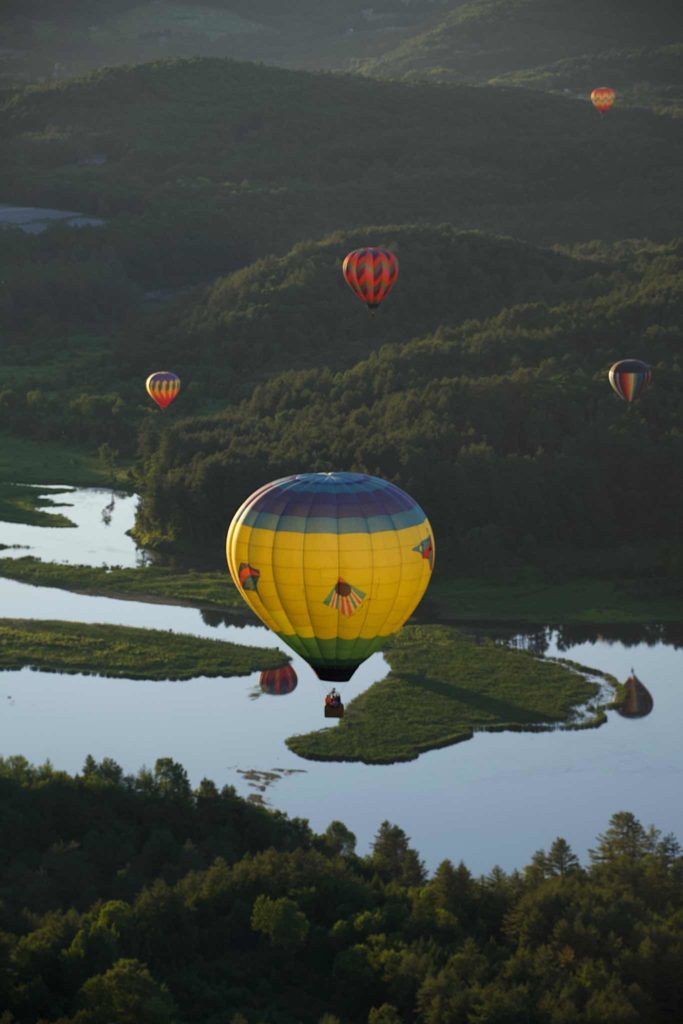


We were probably the fourth or fifth balloon to head out. All the balloons headed south-easterly, over the Quechee Dam, Simon Pearce factory and covered bridge, and toward the Ottauquechee River. Walt tried to drop us down over the river, hoping to pick up a current of air, but the wind didn’t cooperate. We did float over the Quechee Gorge and past the bridge. At various points we could see our reflection, or the reflection of another balloon below us.
Floating in a hot air balloon is very different from flying in an airplane. You’re in the open, for one thing, and you can feel the open air around you. You can turn around and look in any direction. It was crystal clear, and we had the setting sun behind us, so the colors ahead were vibrant, while the balloons behind were backlit. And it’s mostly quiet and serene, punctured by the roar of the burners when it’s time to gain or maintain altitude.
We flew over a bend in the river, and a few farms. At one point, we passed over a stable, and Walt called down to the horses. It was peaceful and quiet, just the four of us in the basket, and the other balloons around us as we floated over the forest.
Around the half hour mark, Walt was starting to look for places to land. We would see little oases of flat ground in the middle of the forest. I could see he had his eye on one likely spot, but the winds would not cooperate, so we hopped over a hill, plowing through some tree tops, before he spotted an open field right beside Route 5, and dropped us gently to the ground.
We met the homeowners, and their children, who were rather wide-eyed about it. Walt helped them up into the basket so they could get a sense of what it was like, while the envelope deflated. The chase crew arrived only a few moments after we landed, and we had to quickly pack up the balloon – we’d taken off late, and had to get back to the festival for the Glow. As a parting gift, Walt left the homeowners a bottle of champagne, a ballooning tradition.
The Glow
After the evening flights, the balloons come back to the Festival grounds for the Glow. By this time it’s dark, and the balloons are re-inflated, tethered in a row, and then the pilots fire off their burners in sync to light the envelopes. It’s very pretty.
Walt’s crew was a little short-handed, so Steve, one of the other passengers, and I helped set the balloon back up. Once the balloon was re-inflated, I got out the camera to take some pictures and video:
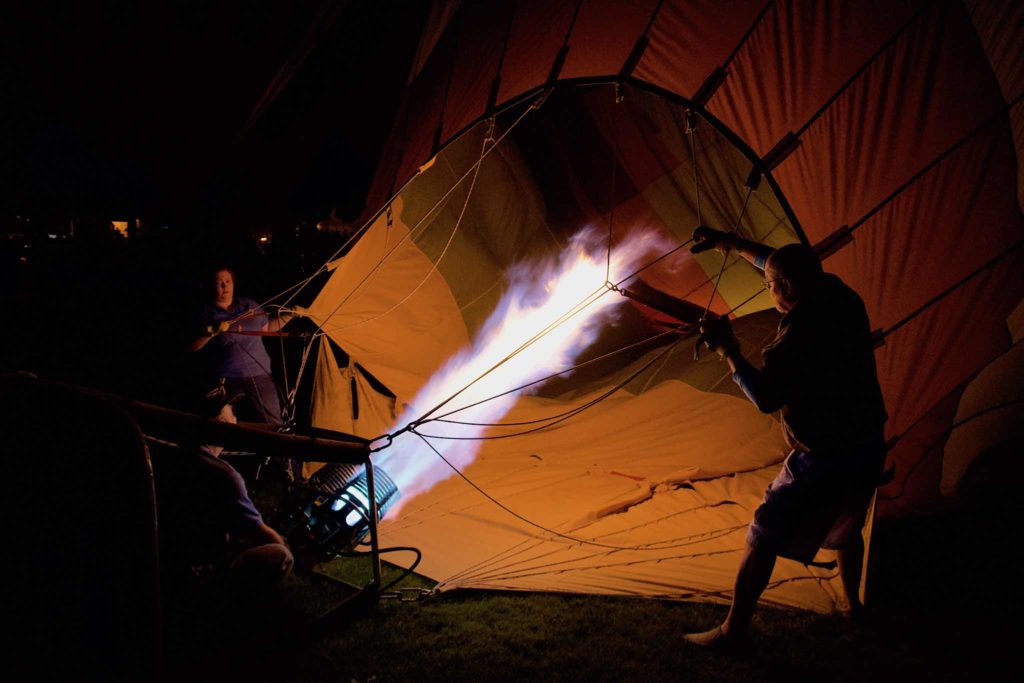


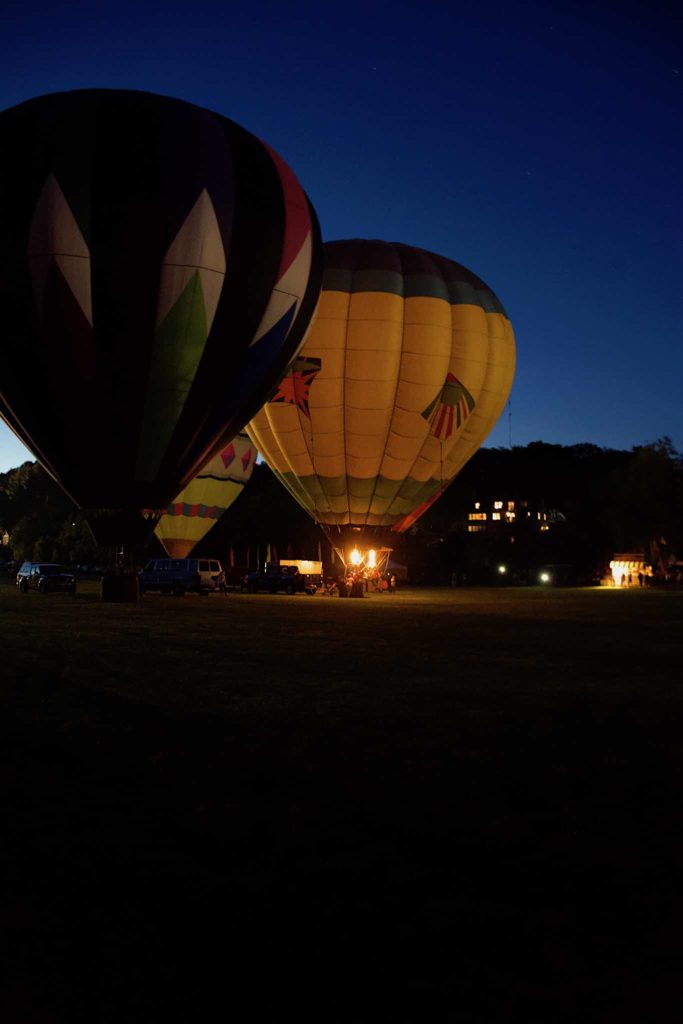










After The Glow, I helped Walt and his crew pack the balloon back up. It had to be deflated, the envelope bound up and packed into its bag, and the basket put on a platform on the back of the van.
Saturday
My plans for Saturday were pretty loose. I wanted to visit the Simon Pearce glass factory again, and then I intended to simply follow Route 4 West on the motorcycle, and see where it took me. During breakfast, Walt called me and asked me if I could drop off the boarding pass from the night before so he could turn it into the festival.
My first stop of the morning was the village of Quechee. There is a dam and a waterfall and a covered bridge there, which I’d flown over the night before. Next to the dam is an old mill, which is now the home of the Simon Pearce store, restaurant and glass factory. They make fine glassware right on the premises. The store is at street level, and the glass factory is at river level.
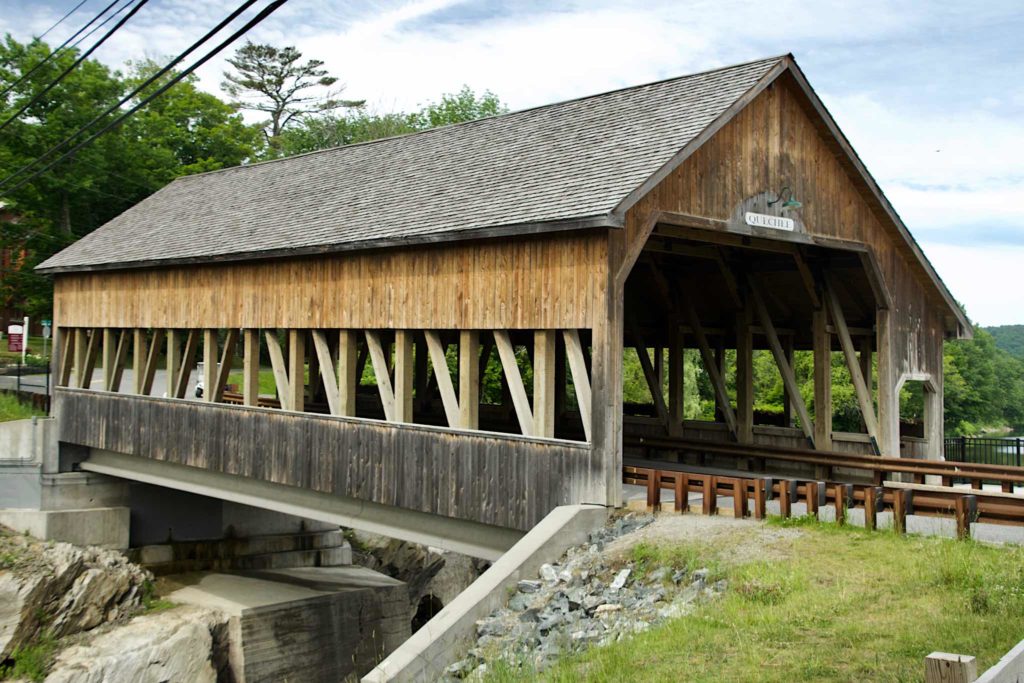










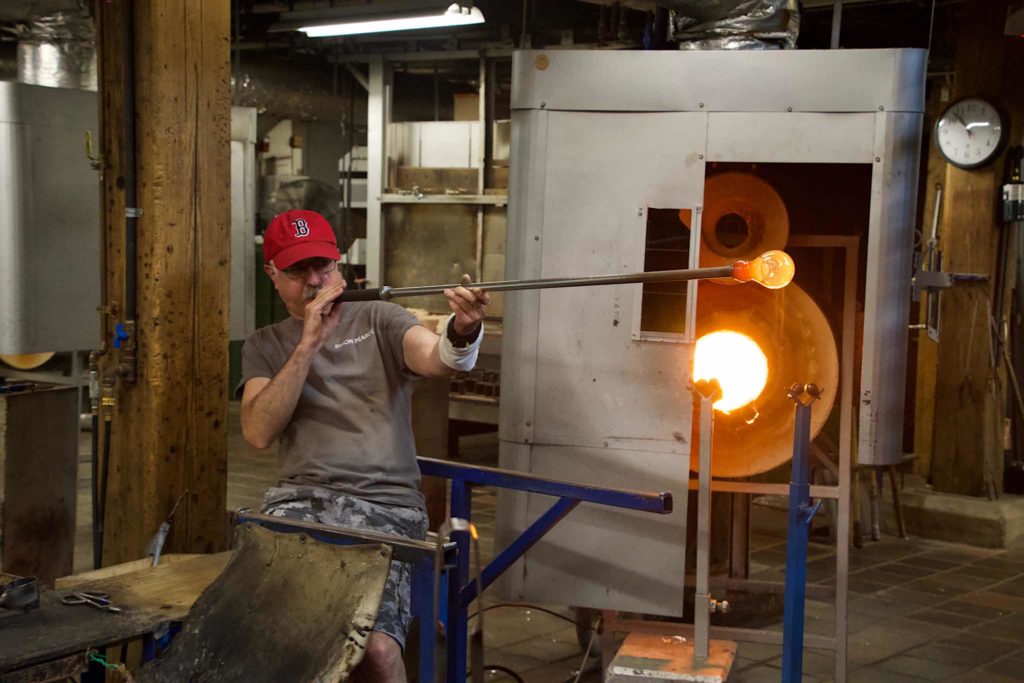

Once I’d picked up a vase for my mother, it was time to hit the road. Route 4 in Vermont is a really nice road for motorcycles — nice scenery, some curvy sections, not too busy, and in reasonable condition. There wasn’t anything in particular I wanted to see, I was just out for the ride.
Serendipity struck though; as I approached the junction of Route 106A, I saw signs directing me to Plymouth Notch, the birthplace of President Calvin Coolidge. “Why not”, I said, so I followed 106A, a fun road in of itself, to the Coolidge homestead.
There’s a small museum, detailing Coolidge’s life, and then you can walk through the village of Plymouth Notch, which, paving aside, is pretty much the way it was a century ago. There is a General Store, operated by his father, the Coolidge Birthplace, which is a small house attached to the back of the store, the house where Coolidge grew up, and where he took the oath of office, and the barn owned by his grandfather, part original and part a restoration. I joined a guided tour and got to see the insides of all these buildings.










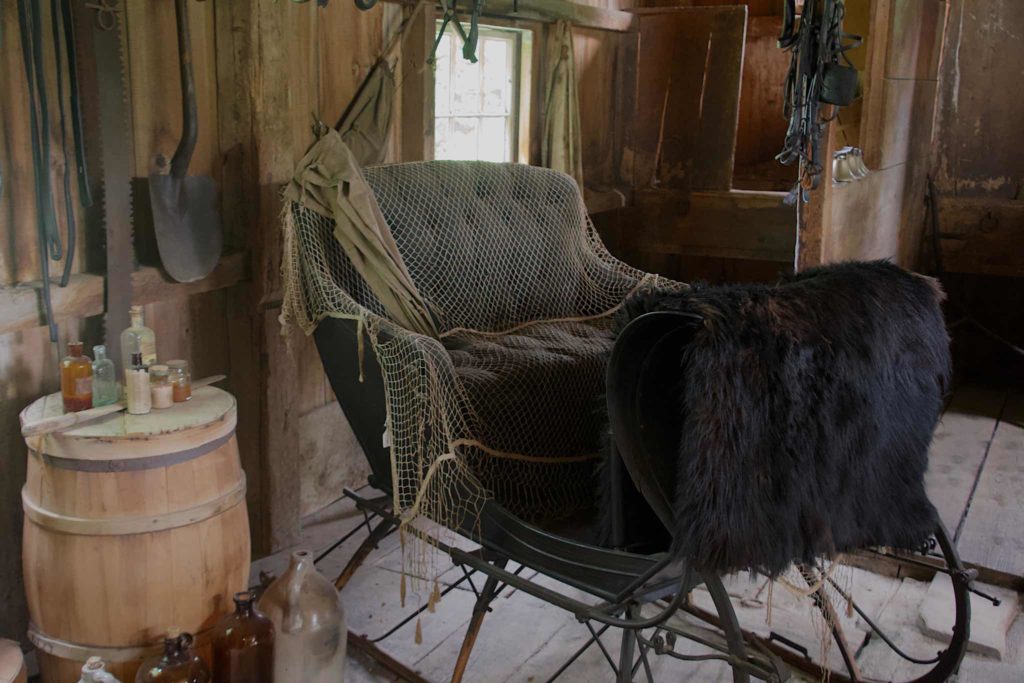

After leaving Plymouth Notch, I headed back up to Route 4, and continued to follow it westward, to the fringes of Rutland, where I turned around, and headed back to the Festival.
When I got there, I found Steve and Kathy from the night before were there too, and together we helped get the balloon set up again, and helped this evening’s passengers into the basket. I was also grabbing shots of the other balloons preparing to take off. Deb offered me the chance to join the chase crew, and I accepted. I did have time before we left to get a few more pictures of the festival.
The chase crew drives the van to where the balloon lands. With luck — and we were lucky this evening — it will get there just as, or slightly before, the balloon lands. Deb, Walt, and their assistant Katherine are all from Ohio, so we had a local friend of theirs, Tiffany, with us, to navigate the roads. There was a GPS beacon aboard the balloon and Katharine and Tiffany were both tracking it; Tiffany chose the route to get us to where they anticipated the balloon would land. This time they forecast it pretty closely; as we traveled along Route 5 we saw the balloon come over the hill; Deb parked the van, and we got out to run to where the balloon was landing.












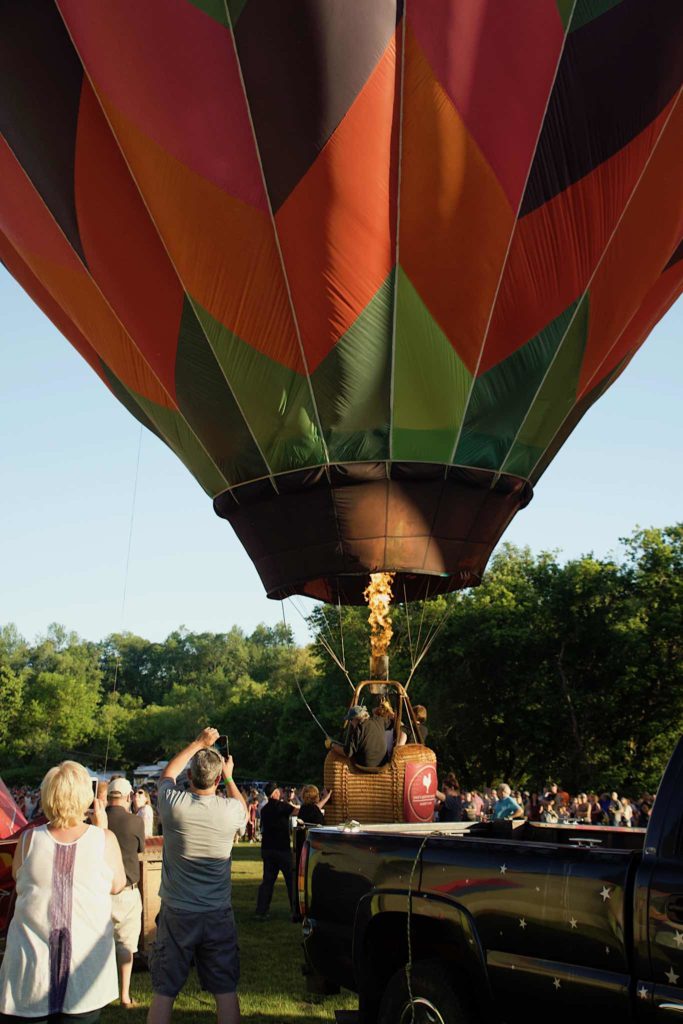






The first order of business when the balloon touched ground was to get rid of its buoyancy. Walt continued to vent hot air out the top of the balloon, and the ground crew held the basket down. If necessary, the pilot will hover an inch or so off the ground while the crew walks the basket to a more convenient spot. Passengers are not allowed to leave the basket until the pilot says so — to lose the weight of the passenger suddenly could cause the balloon to shoot back up. Once Walt gave the go ahead, we helped the passengers out of the basket.
Once the passengers were out, one crew member pulled on a rope attached to the top of the balloon. Gradually, the hot air cooled and escaped, and the envelope settled onto the ground. As it did, the basket was laid on its side, the mouth of the envelope closed, and we started to gather up the fabric of the envelope into a long thick line to drive the rest of the air out. Velcro straps were bound around the envelope at intervals to keep it tidy and compact. Once the envelope was bound up, we got it into its bag. It’s a lot of work, and fortunately the homeowner where the balloon landed helped out. He had a couple of little kids with him and Deb put them to work sitting on top of the envelope as it was put into the bag to drive the air out. Once the balloon is in the bag, we heaved it up into the truck, then hauled the basket up onto a platform on the back of the van and fastened it down.
Once everything was packed away, Walt had a short champagne ceremony with the passengers and homeowners, where he told the story of how the Montgolfier brothers invented hot air balloons, and started bringing champagne with them to reassure the people where their balloons were landing that these strange devices were friendly. Story told, he poured out a cup of champagne for everyone, and left a bottle with the homeowners.
We then headed back to the festival grounds for the Saturday night Glow. Since takeoff hadn’t been as late as our flight, we had a a little more time to get back and get set back up. Once again I helped get the balloon inflated; once it was up, I walked around to to get some more pictures.





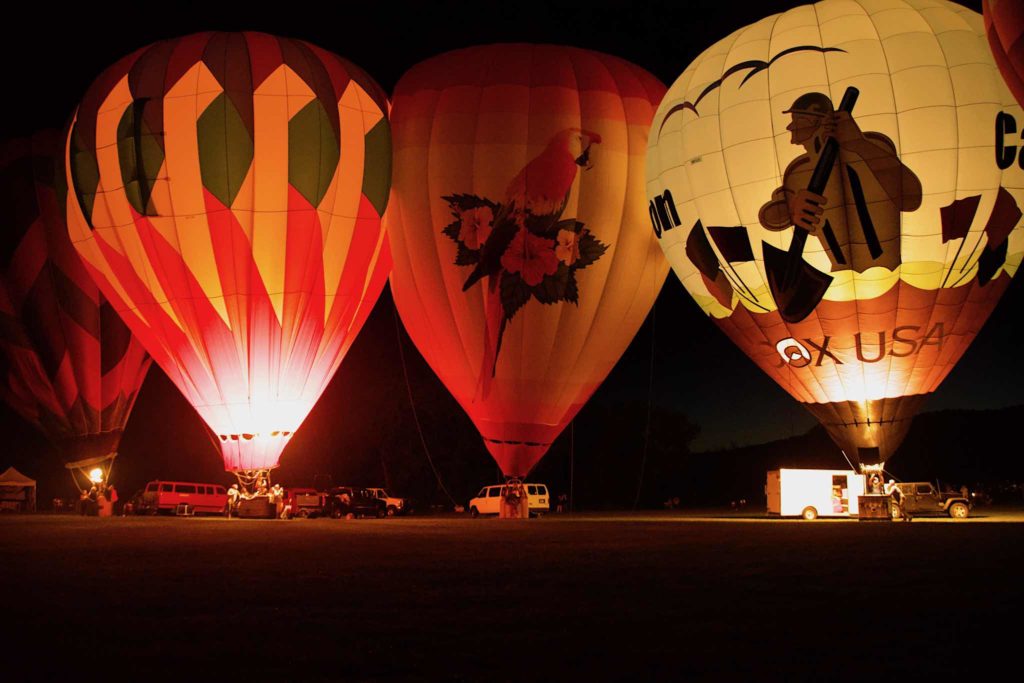





After the glow, I helped pack up the balloon one last time, and then it was time to say goodbye to Walt and Deb, Tiffany and Katherine.
The ride back the next day was uneventful. Since I was in no particular hurry this time, I took Route 4 back through New Hampshire. The weather and scenery were great. Route 4 ended at I-93; after a few miles of backed up traffic I got off the interstate and onto Route 3A. While on this road I made an interesting discovery: I was passing along the a river, and I had a nice view of it from the bike, so I stopped to get some pictures of it. I walked back nearly a mile, but found no spot where I had a clear shot of the river; my mind must have stitched together the flashes of the river as I rode by into one continuous vista that didn’t really exist.
I got home just before four, just in time to run some errands. Overall, I had a great time. I loved being in a balloon again, and it was fun helping out, despite the fact that it’s surprisingly physical work. It was good taking the bike on a longer trip, and hopefully I can work my way up to even longer ones.
Quabbin via Motorcycle
Image
Around the start of the last century, water shortages in Greater Boston caused the state government to look to Western Massachusetts for supplies of clean drinking water. The Wachusett Reservoir was completed around 1908, and in the Twenties, the people of the Swift River valley lost their battle against eastern Massachusetts, and construction of the Quabbin Reservoir begun. The towns of Enfield, Greenwich, Prescott and Dana were disincorporated, their citizens evicted from their homes, and all structures in the way of the future reservoir razed. Construction took place during the thirties, and the reservoir filled during the forties, becoming the largest inland body of water within the Commonwealth of Massachusetts.
Today, it supplies most of eastern Massachusetts with water. To protect the water, the area around it is a reservation. Yesterday, I took the motorcycle out for a ride around there. The roads around the reservoir are great for motorcycling — curvy, and not too crowded.
…Hello FJR 1300
Under threatening skies, I took the Katana for my last ride, down to MOM South, the dealership in Foxboro I bought the new bike from. There were thunder showers prowling the area, so I didn’t take it for one last ride through the Blue Hills. Heading south on I-95 through Walpole I got poured on momentarily, and then I was out of it.
After a short wait, I was called into the office to do the paperwork. It always seems like I’m signing a peace treaty when I buy a vehicle; there are so many things to sign. Finally, though, I’d turned over my down payment and signed off on the loan, I was the proud owner of a new Yamaha FJR 1300-ES and it was time to wait for the new registration to come through.
While I was waiting, the bike was waiting for me out front. I walked out, and took a look. It’s beautiful. It’s sleek and black, and big. Looking at it from the rear, I was looking at the built-in saddlebags, and started idly wondering if I’d be able to get it past the car in the driveway into the garage. The dashboard integrates into the fairing, and it’s big. It’s a sport touring bike, and I’d been thinking of it as a sport bike I can take touring, but it’s starting to come home to me that it’s a sporty touring bike.
As they were finishing up with the registration work, John Brooks gave me a very detailed rundown of the all the controls and features. It has a lot of amenities, and a lot of thoughtful touches. He very carefully walked me through them, but I’m looking forward to working my way through the owner’s manual.
Finally, the registration was transferred, and they moved the license plate from the Katana to the FJR. John recommended I rehearse a little in their large open parking lot, so I did – first one circle the width of the lot, then another half the width. With rain in the area, and needing to get back to work, I then headed back north on Route 1 towards home. As I left, I saw them putting the Katana away.
I was grinning most of the way back. This bike is so much more comfortable, and yet, is nearly as responsive as the Katana. It’s got power to spare. The only drawback is trying to move it at very very slow speeds, where I do feel its extra weight, and am cognizant that my feet barely reach the ground. But I’m already starting to get more comfortable with finessing it around.
I got to Route 128 around 3:30. If rush hour hadn’t already started, I would have taken it through the Blue Hills. Instead, I came home and got back to work. I put in a bunch of extra hours last night, and didn’t feel that I needed to make up time. Instead, I got what I was working to a break point, and tried out my new toy. I took it up through Chickatawbut Road, then back through town to Cobbs Corner, but had to cut my ride short due approaching thunderstorms.

Goodbye, Katana…
Tomorrow, shortly after noon, I’ll be taking my 2002 Suzuki Katana for my last ride, to the dealership to be traded in. I’ve had it for almost exactly 15 years.
Getting the paperwork together, I found that I bought it from the old South Shore MotorSports in Quincy July 1, 2002. I bought it to replace my first bike, a Kawasaki EX 500, which I’d damaged in an accident the previous fall. Even before the accident, the EX-500 had been getting unreliable, and once you’ve lost the trust in a bike, it’s hard to get it back. I saw no reason to spend hundreds of dollars replacing broken body work on it.
A big part of the reason I chose this model was because it was supposedly a more comfortable bike — less radical than Suzuki’s GSXR, less expensive than Honda’s CBRs. When I was looking at it in the showroom, I fell in love with it. It was bright yellow, and after the accident, that was reassuring — you’d have to be blind to not see it. My Aunt Dot once called it my “bumblebee”. On the ride home, I was impressed with how smooth the engine sounded. The EX-500 had been a parallel twin-engine; this was an inline four, and it sounded a lot smoother.

Suzuki Katana 600
I was able to take some longish rides on it. I made it out to Quabbin Reservoir a couple of times. I made my longest trip, along the Mohawk Trail, during Labor Day Weekend of 2005. I took the masthead image from the top of Mount Greylock during that trip. And I took it up to the White Mountains in 2006 and 2008.
Unfortunately, I found “comfortable” was a relative term. While it might have had a more relaxed riding position than a GSXR, the handlebars were a lot lower than the old EX-500, and it was correspondingly less comfortable. Especially at the beginning of the season, I was likely to develop a stabbing pain between my shoulder blades after riding a while.
It’s held up pretty well. I had a slow speed slip on a patch of wet leaves at the top of the street Halloween afternoon about four and a half years ago; I shattered the face of my iPhone, and scuffed up the side of the bike and helmet, and leaving a chain and lock bungeed to the back handle has added more scuff marks and black marks. But it still runs very well.
I started to think about replacing it a couple of years ago. I was starting to notice it was requiring more repairs more often. Nothing too serious, just time taking its toll. I was starting to trust it less. So I started thinking about what I wanted to replace it with. One the one hand, sport touring has appealed to me for a long time. On the other hand, Harleys are much more common around here than sport bikes. I’ve rented Harleys a number of times, and had a blast every time. I felt I was at a fork in the road.
Tomorrow I pick up the new bike. Shortly after the last video conference of the day, I’ll take the Katana on my last ride. I might take it through the Blue Hills one last time, then take it to the dealership. I hope they’re able to sell it to someone who enjoys it as I have.
New Hampshire by FJR 1300
Gallery

This gallery contains 2 photos.
This past weekend, I rented a Yamaha FJR 1300 and took a trip up through New Hampshire. The FJR is a “sport-touring” bike – power and handling like a sport bike, and a fairing like a sport bike, but more … Continue reading
Features vs Quality
Yesterday’s motorcycle ride reminded me once again that sometimes quality is better than a whole bunch of features, and that fit counts.
Late in the summer, I bought the Scorpion EXO 900 helmet. It’s a modular helmet that allows you to flip up the chin bar– in fact, you can even take it off, and use it as a three quarter helmet. I’ve been wanting a modular helmet since the last time I took the camera with me and had to take the helmet off every time I stopped to take a picture. In the store, I fell in love with the retractable sun shield, and allowed myself to be talked into a snugger fit, on the theory that it will only get looser, and you want a snug fit.
For me, though, it’s turned into one uncomfortable helmet. It’s heavy, and after a while, the weight gets to you. And the tightness around the ear pads gets to me after awhile. It just doesn’t feel good after awhile. It sort of reminds my of my first helmet, a Bell, that wasn’t very comfortable either.
This was borne home to me yesterday when I wore my old Shoei. It’s not modular, but it’s light, and comfortable, and it felt so good. I could have ridden even further if I hadn’t been anxious to get a bicycle ride in.
I’ll probably keep the Scorpion around for rides when I think I’ll need the modularity, but will stick to the Shoei or Arai for most of my riding.
